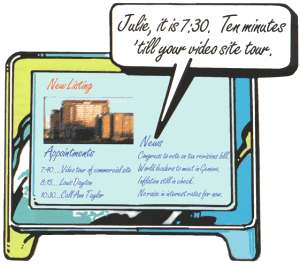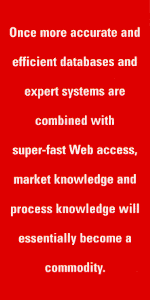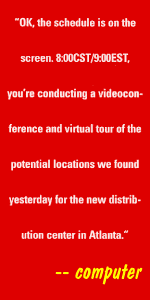Imagine having the technological resources to run highly effective corporate real estate-related meetings around the country-or world-in a single day without leaving your office. Sound far-fetched? Here is a glimpse into the corporate real estate profession 10 years from now.
We all know that the Internet is changing the way business is conducted in almost every industry. The extent to which these changes may “brokers” or “agents” of information, could be dramatic. In the commercial real estate “brokerage” industry, traditionally three types of knowledge were required to service both users and owners of real estate: market knowledge (an understanding of real estate conditions, including available properties, prices, construction and vacancy trends), process knowledge (skill in conducting a real estate transaction by utilizing and managing the necessary resources and expertise, such as financing, legal and negotiating techniques) and client knowledge (an understanding oh how real estate is utilized and accounted for within a company’s business organizations.
Once more accurate and efficient databases and expert systems are combined with super-fast Web access, market knowledge and process knowledge will essentially become a commodity. This will significantly change the way this industry currently functions. To illustrate how this change may manifest itself, consider the following scenario, involving a day in the life of a real estate manager (in-house or working on behalf of a corporate client in an outsourcing arrangement) for a large corporation with numerous real estate locations around the world. The year is 2010.

July 7, 2010
7:32am/CST
Julie Lu walks into the small office in the remodeled attic of her house in McKinney Texas, about 30 miles north of Dallas. The motion detector on her computer senses her presence and immediately turns on all of its systems, the two monitors on the desk and connects to the firm’s mainframe computer in New York.
“Good morning Julie, you’re looking well today,” the computer remarks.
“Yeah, right,” she responds after drinking from her cup of coffee and looking at a stack of unopened mail on the side of her desk.
“Do you want to start with your preferred procedure: schedule, e-mails, then work in progress?” the cool, deep voice queries.
“Yes, please,” she responds, still fumbling with the stack of hard mail.
“Okay, the schedule is on the screen. 8:00CST/9:00EST, you’re conducting a videoconference and virtual tour of the potential locations we found yesterday for the new distribution center in Atlanta. Let’s see; it looks as if there are 44 people planning to attend. That beats the Toronto tour we did last week by eight.”
“That’s fine, this is the best way, flushes everything out early,” Julie notes.
“I’m assuming it will take about an hour for you to present the market conditions, conduct the tour and then discuss the next steps and procedures. I’ve already put together an electronic package with all the data and electronic forms they need to fill out for the business case and the company’s standard Capital Appropriation Request.”
“Good,” acknowledges Julie. “Did we get confirmation on the accuracy of the Atlanta database?”
“Every property except for one has been confirmed,” the computer replies.
“Remind me to present the standard disclaimer regarding data reliability.”
“Will do. I’ll also tell you when it’s 7:50 so you can freshen up a little.”
“Gee, thanks.”
“I’m allocating 90 minutes to do the entire call, assuming introductions and other things.”
“That should work.”
“At 9:30, you can break for a few minutes. 9:45CST/8:45MST is your physical tour in Denver with
John Mulhern’s group for the new regional office,” the system continues. “They’ve picked three buildings, one of which is an expansion at their current location. It’s just going to be John and his two Senior VPs. They want to see if they can do the tour and be back for an 11:00 MST conference call.”
“No problem. Are they still looking at about 50,000 square feet?”
“Yes. All the headcount data they’ve provided project right around 250 people in two years.”
“Does John have the video feed, is the satellite link allocated?” Julie asks.
 “Yes, everything is ready. I’ve scheduled appointments with the current landlord at 9:00MST to look at the two floors which will be available in five months. At 9:30MST we’re touring a building that’s owned by one of our multiple location landlords. And 10:15MST is the new building tour which, of course, is the one they like.”
“Yes, everything is ready. I’ve scheduled appointments with the current landlord at 9:00MST to look at the two floors which will be available in five months. At 9:30MST we’re touring a building that’s owned by one of our multiple location landlords. And 10:15MST is the new building tour which, of course, is the one they like.”
“Of course.”
“It is also the most expensive.”
“Yep!”
“In between appointments, during the down time, you can try and catch-up on e-mails.”
“Should be easy.”
“All the buildings are in relatively close proximity, so we should get them back to their office in time, assuming there are no problems. You can conduct the debriefing on their way back to their office.”
“Sounds good,” she casually responds after yawning and stretching her arms.
“After you get through there, you jump into your noon/EST video conference lunch with your boss and all the other real estate managers to discuss the new IT standards. I’ve already informed her you may be a little late.”
 “Good.”
“Good.”
“By the way, looks like she’s in the office today,” the computer observes.
“In New York?”
“Yes.”
“Really, why?” Julie wonders.
“I don’t know.”
“Hmm, that’s odd, she was just in the office on Monday.”
“She hasn’t been in the office on a Wednesday since the second week in February.”
“Well, keep looking and see if you can find why she’s there,” Julie replies as she stands up, stretching her neck and back.
“Not enough sleep?”
“Well, the baby was up a couple of times in the middle of the night,” says Julie.
“Does the schedule look too tight?”
“No, we’ll get through it. How does the afternoon look?”
“The call is scheduled for 60 minutes. I’ve given you 60 minutes to exercise, if you want.”
“Thanks, I’ll take a walk. Do I have any more video calls in the afternoon?”
“Yes.”
“Darn! That means I’ve got to take a shower and put on makeup,” Julie notes.
“You could let me touch up your video image.”
“Yeah. I hate to do that, but I think I may take you up on the offer.”
“Okay. Do you want me to continue?”
“Sure.”
“I’ve got you cranking back up at 2:00. We need to analyze and send out the reports on the proposals received for the office renewal in Indianapolis, the new service center in Schaumburg, and the expansion of the lab in Houston.”
“Are they all in electronic format?” asks Julie.
“One of the owners in Indianapolis didn’t respond in the proper format.”
“Send them the standard noncompliance response. Tell them if they can’t get their proposals to us pursuant to industry standards by this afternoon, we’ll have no choice but to eliminate
them.”
“Done. I’ll follow up again right before lunch.”
“Thanks.”
“About ten, fifteen minutes there?”
“Max.”
“I then gave you until 2:30 to do a few miscellaneous things,” the system relates.
“My brother called again?”
“Yes. I would venture to guess there’s more girlfriend problems.”
“Probably.”
“I thought that would be a good time to call him. At 2:30 you need to interview three
contractors in Tampa for the new area office there. I checked, and they all have compatible videoconference systems. I don’t anticipate any technical problems.”
“Did you check their references and insurance carriers?”
“Yes. You can review the report before we do the interview.”
“Any surprises?”
“One has had some issues on a recent job with some suppliers, and one seems to be stretched a little thin with his subcontractors.”
“Well, pretty typical. I’ll check it out later.”
“I allocated 15 minutes apiece.”
“Okay.”
“At 3:15, you can return a couple more calls,” says the computer. 3:30, you need to pick whom you’re going to use for janitorial services at the plant in Newark. Then you need to do the final negotiations on the services contract.”
“Hmm. I like that Capital Building Services Group,” Julie thinks out loud.
“I thought you would. Philip Jefferson is expecting your call at 3:45CST/4:45EST. You can negotiate the details of the contract with him.”
“Yep,” she replies, nodding her head.
“At 4:30, you need to analyze the operating expense pass-throughs at the Seattle sales office and the parts center in Richmond and determine if they are in line with the market. Finally, I’ve scheduled you to finish the appraisal on the old regional office building in Boston. The approval came in today to start the disposition process.”
“Pretty full day,” she states idly.
“If it’s too much, I could rearrange some things.”
“No, it’s okay. Let’s get started so I can ‘freshen-up’ at 7:50.”
Continue to next page

 “Yes, everything is ready. I’ve scheduled appointments with the current landlord at 9:00MST to look at the two floors which will be available in five months. At 9:30MST we’re touring a building that’s owned by one of our multiple location landlords. And 10:15MST is the new building tour which, of course, is the one they like.”
“Yes, everything is ready. I’ve scheduled appointments with the current landlord at 9:00MST to look at the two floors which will be available in five months. At 9:30MST we’re touring a building that’s owned by one of our multiple location landlords. And 10:15MST is the new building tour which, of course, is the one they like.” “Good.”
“Good.”